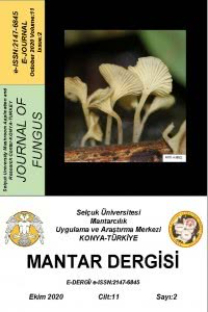Doğal Ortamdan Toplanan Lepista irina (Fr.) H.E. Bigelow’nın Yağ Asidi İçeriğinin Belirlenmesi
makromantarlar, yağ asitleri, Türkiye, Lepista irina, Lepista irina, Yozgat, Yozgat
Determination of Fatty Acid Content of Lepista irina (Fr.) H.E. Bigelow Collected From Natural Environment
Lepista irina, Macrofungi, Fatty Acids, Yozgat, Turkey,
___
- Agrahar-Murugkar, D. ve Subbulakshmi, G. (2005). Nutritional value of edible wild mushrooms collected from the Khasi hills of Meghalaya. Food Chemistry, 89(4), 599.
- Barros, L., Venturini, B.A., Baptısta, P., Estevinho L.M., ve Ferreira I.C.F.R. (2008). Chemical Composition and Biological Properties of Portuguese Wild Mushrooms: A Comprehensive Study. J. Agric. Food Chem., 56 3856–3862.
- Bengü, A. (2019). Some elements and fatty acid profles of three different wild edible mushrooms from Tokat province in Turkey. Progress in Nutrition, 21(1) 189-193.
- Bon, M. (1987). The Mushrooms and Toadstools of Britain and North-Western Europe. Hodder-Stoughton, London, 352 p.
- Breitenbach, J. ve Kränzlin, F. (1991). Fungi of Switzerland. Vol: 3, Boletes and Agarics 1. Part, Verlag Mykologia CH-6000 Luzern 9, Switzerland, 361 p.
- Christie, W.W. (1990) Gas chromatography and lipids. The Oil Press, Glaskow, 302 p.
- Çağlarırmak, N., Ünal, K. ve Ötles, S. (2012). Nutritional value of Edible Mushrooms Collected from the Black Sea Region of Turkey. Mycologia Aplicada International, 14(1) 1-5.
- Demirbaş, A. (2001). Concentrations of 21 Metals in 18 Species of Mushrooms Growing in the East Black Sea Region. FoodChemistry, 75 453-457.
- Diez, V. A. ve Alvarez, A. (2001). Compositional and nutritional studies on two wild edible mushrooms from northwest Spain. FoodChem., 75 417-422.
- Durmaz, F., Şimşek Sezer E.N. ve Aktaş S. (2018). Yenilebilir Bir Tür Olan Lycoperdon utriformis Bull.’in Yağ Asit Kompozisyonlarının Gaz Kromatoğrafisi (GC)’de Tayin Edilmesi. Mantar Dergisi, 9(1) 50-53.
- Hara, A. ve Radin, N.S. (1978) Lipid Extraction of Tissues with a Low-Toxicity Solvent, Analytical Biochemistry, 90 420–426.
- Harvey, R.A. ve Ferrier, D.R. (2011). Biochemistry 5th edition, Lippincott Williams & Wilkins, a Wolters Kluwer business. 182.
- Manzi, P., Aguzzi, A. ve Pizzoferrato, L. (2001). Nutritional value of mushrooms widely consumed in Italy. Food Chemistry, 73 321–325.
- Mendil, D., Uluözlü, Ö.D., Hasdemir, E. ve Çağlar, A. (2004). Determination of trace elements on some wild edible mushroom Samples from Kastamonu Turkey. Food Chemistry, 88 281-285.
- Moser, M. (1983). Keys to Agarics and Boleti. Gustav Fischer Verlag, Stuttgart, 535 p.
- Murray, R. K., Granner, D.K., Mayes P.A. ve Rodwell V.W. (2003). Harper’s Illustrasted Biochemistry, twentysix edition, McGraw-HillCompanies, 593.
- Phıllıps,, R. (1981). Mushrooms and Other Fungi of Great Britain &Europe. Pan Books Ltd., 288p, London.
- Racz, L., Papp, L., Prokai, B. ve Kovacz, Z. (1996). Trace element determination in cultivated mushrooms: an investigation of manganese, nickel, and cadmium intake in cultivated mushrooms using ICP atomic emission. Microchemical Journal, 54 444–451.
- Sanmee, R., Dell, B., Lumyong, P., Izumori, K. ve Lumyong, S. (2003). Nutritive value of popular wild edible mushrooms from northern Thailand. Food Chemistry, 82 527-532.
- Sharma, S.K. ve Gautam, N. (2015). Chemical, Bioactive, and Antioxidant Potential of Twenty Wild Culinary Mushroom Species. BioMed Research International, 2015, 1-12.
- Toledo, C.V., Barroetaveña, C., Fernandes, Â., Barros, L. ve Ferreira, I.C.F.R. (2016). Chemical and Antioxidant Properties ofWild Edible Mushrooms from Native Nothofagus spp. Forest, Argentina. Molecules, 21 1201.
- Tvrzicka, E., Kremmyda, L.S., Stankova, B. ve Zak A. (2011). Fatty acids as biocompounds: Their role in human metabolism, health and disease – a review. part 1: classification, dietary sources and biological functions. Biomedical Papers, 155(2) 117-130.
- Üstün, O. (2011). Makrofungusların Besin Değeri ve Biyolojik Etkileri. Turk hij. Den. Biyol. Derg., 68(4) 223-240.
- Woldegiorgis, A.Z., Abate, D., Haki, G.D., Ziegler, G.R. ve Harvatine, K.J. (2015). Fatty acid profile of wild and cultivated edible mushrooms collected from Ethiopia. Journal of Nutrition & Food Sciences, 5(3) 360.
- Yıldız A., Karakaplan, M. ve Aydın, F. (1998). Studies on Pleurotus ostreatus (Jacq. Ex Fr.) Kum var. Salignus (Pers. Ex Fr.) Konr. Et Matubl.: cultivation, proximate composition, organic and mineral composition of carpophores. Food Chem., 61 127-130.
- Yılmaz, N., Solmaz, M., Türkekul, İ. ve Elmastaş, M. (2006). Fatty acid composition in some wild edible mushrooms growing in the middle Black Sea region of Turkey. Food Chemistry 99 168–174.
- ISSN: 2147-6845
- Yayın Aralığı: Yılda 2 Sayı
- Başlangıç: 2010
- Yayıncı: Selçuk Üniversitesi Mantarcılık Uygulama ve Araştırma Merkezi Müdürlüğü
Fatih BAYDAŞ, Ebubekir ALTUNTAŞ
Konya Selçuk Üniversitesi Hastanesi’ne Başvuran Hastalarda Saptanan Dermatofitler
Ekin ERYILMAZ, Rugıyya SAMADZADE, Salih MAÇİN, Duygu FINDIK
Küresel Gıda Güvenliği Riski: Ug99 Kara Pas Irkı
Yenebilir ve Tıbbi Mantarların Gıda Ürünlerinde Kullanım Potansiyeli
Sanem BULAM, Aysun PEKŞEN, Nebahat Şule ÜSTÜN
Elif Sena KIRMIZIKAYA, İnci ÇINAR
Hericium erinaceus (Bull.) Pers. İçin Yüksek Verimli Hibrit Bireylerin Belirlenmesi
Erbil KALMIŞ, Mehmet ATMACA, Fatih KALYONCU
Desarmillaria tabescens’in in vitro Antimikrobiyal Aktivitesi
Kerem CANLI, Atakan BENEK, Merve ŞENTURAN, İlgaz AKATA, Ergin Murat ALTUNER
Tricholoma anatolicum ve Tricholoma caligatum’un Morfolojik ve Moleküler Yönden Karşılaştırılması
Meryem BOZKURT, Şenay İLBAN, Sinan AKTAŞ, Tuna UYSAL
Bazı Uygulamaların Mantar Muhafazasında Kullanımı
